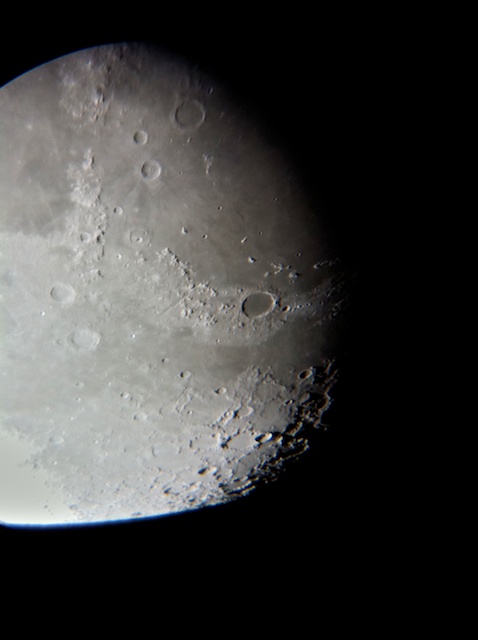 |
Report Date: 11 June 2011 |
|
|
| Follow @mweasner | Welcome | Photos | Equipment | Links | Data |
First, some Site notes. I have migrated the Links and Data pages from their former location. The new pages are now accessible from the navigation menu on all pages. Next to be moved is the Equipment page.
Thursday, 9 June, it was clear but still windy. We were also having DSL speed problems again and I had to wait for a call back. So, no observing that night. There was no call-back that night but the DSL speed was resolved overnight, and they called back Friday morning. Friday, 10 June, it was clear all day but windy at times. The observatory was opened at 1814 MST, 101°F. I first secured the SkyWire and RS-232 serial cables for a more "permanent" use. At 1830 MST, the telescope was powered on and I went to the moon. My plan for the evening was to do a lot of iPhone lunar imaging at various magnifications. This first photo was taken about 50 minutes before sunset, afocal with 26mm eyepiece (77X), using the MX-1 iPhone Afocal Adapter:

The photo shows the nice blue sky surrounding the moon. The view of the moon in the blue sky was pretty, so at 1919 MST, I took this photo with the iPhone showing the 8" LX200-ACF pointed at the moon:

While waiting for the sky to darken, I did some testing of "Pocket Universe Express" for an upcoming review.
At 1922 MST, slewed to Saturn. It was very nice in the 15mm (133X) eyepiece. No moons were currently visible; the sky was still too bright. I then went back to the moon; seeing was excellent this night. I viewed the moon with the 15mm, 9.7mm (206X), and 5.5mm (364X) eyepieces. The views along the terminator were incredibly detailed in the 5.5mm eyepiece. And the details seen in and around the crater Copernicus were fascinating. Both polar regions showed nice "relief" and details. I then decided to "push" the magnification beyond the 8" theoretical maximum of 400X. With the 5.5mm + 2X Barlow Lens (727X), the views along the terminator were very nice and sharp. With the 5.5mm + 3X TeleXtender (1091X), the views were a little "fuzzy" but still nice. I backed off the magnification by using the 9.7mm + 3X TeleXtender (619X); the views were really nice and distinct. Copernicus was incredible to observe, with lots of nice details in and round the crater. At 2000 MST, I began setting up for iPhone lunar imaging. I switched from the star diagonal to the visual back and took these afocal images.
26mm eyepiece (77X):

26mm eyepiece + 2X Barlow Lens (154X):


9mm eyepiece (222X):



9mm eyepiece + 2X Barlow Lens (444X):



Crater Copernicus, 9mm + 2X Barlow Lens (444X) with some digital zoom in the Camera app:

See, I said the details in and around Copernicus were fascinating.
9mm eyepiece + 3X TeleXender (666X):



Imaging was ended at 2050 MST. I then did some more lunar observing using the 5.5mm eyepiece. The views of craters, mountains, and shadows along the terminator are always a joy to view. I then slewed to Saturn and viewed it in the 5.5mm eyepiece. Four moons were easily seen, and possibly a 5th moon. I checked SkySafari 3 Pro and discovered that there were only four moons seen: Titan, Tethys, Rhea, and Dione. What I thought was the moon Iapetus was a star. I switched to the 9.7mm eyepiece and tried for Enceladus, but it was too close to the planet to be seen. At 2120 MST, the wind began gusting strongly.
Closed the observatory at 2145 MST, 76°F.
I have posted my reviews of SkyWire, SkySafari 3 Plus, and SkySafari 3 Pro. I have also completed my "Slow Shutter Cam" review. Click the links to read them.
Go to the previous report.
Return to the Cassiopeia Observatory Welcome Page.